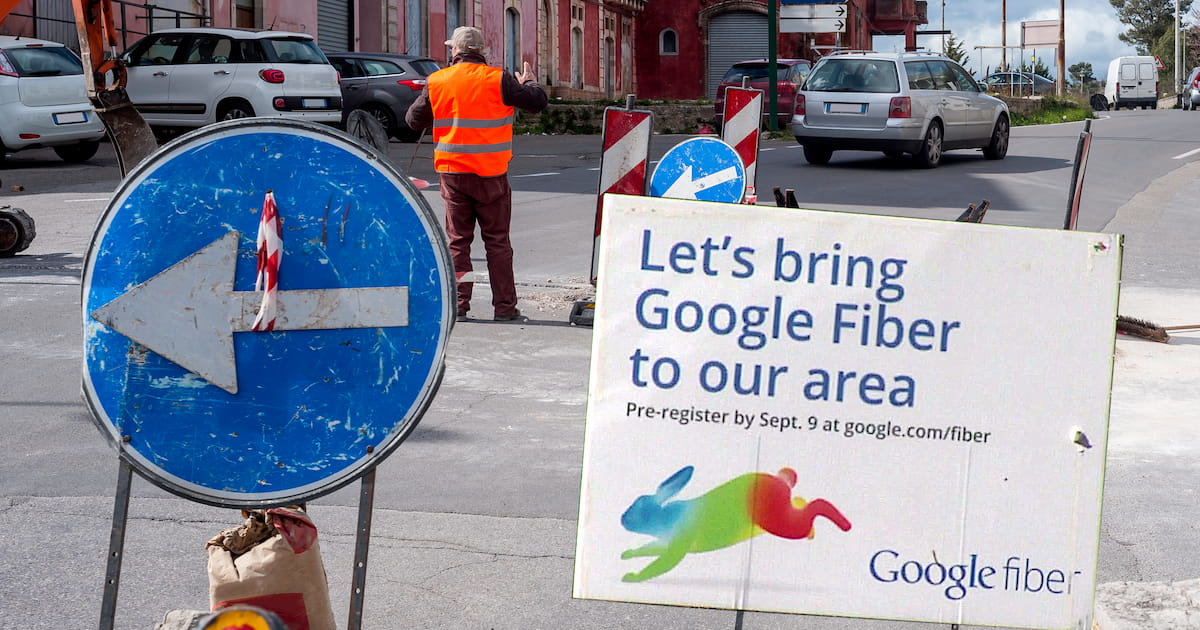The Best Internet Speed Test Tools for Your Wi-Fi
Wi-Fi 6E opens up a whole new frontier for Gig+ wireless speeds.
Jan 27, 2023 | Share
Technology
An internet speed test is the measuring tape of the World Wide Web—a handy tool no netizen should live without.
Speed tests give you an accurate reading of your download speeds, upload speeds, and latency. You can use a speed test to determine if your Wi-Fi is fast enough for activities like streaming and video calls, and you can run speed tests to figure out if your internet provider delivers your plan’s promised speeds.
There are tons of speed test tools available to use for free online, but some are better than others. Of course, we here at HighSpeedInternet.com favor our own speed test the most. But we’ve used a ton of other speed tests as well, so read on for our guide to the best internet speed tests.
If you’re unhappy with your Wi-Fi speeds, you can try upgrading your service or even switching to a faster internet provider.
Run a search with your zip code below to see speedy Wi-Fi options in your area.
How to take a speed test
You can take a speed test simply by clicking the button to run a test on whatever test you’re using. To get the most accurate results, make sure to close out apps and browser windows so you don’t tax your bandwidth with unnecessary traffic. You can even plug your computer directly into your router via Ethernet.
Internet speeds tend to fluctuate—you’ll never get a single, fixed speed—so it’s best to run multiple tests to get a broader understanding of your internet’s capabilities. You can also run tests at different times throughout the day to see how your download and upload speeds fluctuate around factors like more users and increased traffic.
Best speed tests
| 6 GHz pros | 6 GHz cons | Formats | Take speed test | |
|---|---|---|---|---|
| Most user friendly | HighSpeedInternet.com Speed Test | Data points covering statewide averages and zip code tool to find internet providers | Desktop, mobile browser, Android/iOS app | Take the test |
| Most customizable | Ookla Speed Test | Multiple choices for test servers, archived test results for account holders, VPN access over app | Desktop, mobile browser, Android/iOS app, premium Android/iOS app | Take the test |
| Most practical | M-Lab Speed Test | Quick accessibility over Google, open source code, public data archive | Desktop, mobile browser | Take the test |
| Most fun | Meteor Speed Test | Meteor-themed visuals, color-coding to rate your speeds, Clippy-style virtual assistant | Android/iOS app | Take the test |
| Most interesting | SpeedOf.me Speed Test | Dynamic testing functions | Desktop, mobile browser | Take the test |
Most user friendly: HighSpeedInternet.com Speed Test
Obviously we’re biased, but we love our test because it’s easy to use and full of helpful info. Drop-down FAQs give you insights into how the speed test works and how your internet’s performance compares with other users in your same state and with your same internet provider. You can’t choose a test server like you can on Ookla’s test, but if you’re shopping for internet, you can take a look at a detailed list of internet providers serving your area to see what other plans and speeds are available. We also have an app that gives you a simplified readout of your download and upload speeds.
Most customizable: Ookla Speed Test
Ookla’s speed test is the industry standard—fitting for a brand whose homepage is literally speedtest.net. Ookla’s test is reliable and packed with useful information. You can keep a record of all the tests you take if you sign up for an account, and the desktop browser version lets you change test servers to come up with more nuanced diagnostics. The app comes with a free VPN, and you can buy a premium, ad-free Ookla app for a dollar, which may be worth the investment, considering both the app and browser version can get cluttered with banner ads.
Most practical: M-Lab Speed Test
Type “internet speed test” or “Wi-Fi speed test” into Google, and this one pops up. You can run a test instantly without even going to a website. This open-source test, designed by Google-backed Measurement Lab, archives all its data and makes it available online for public perusal. You can even use M-Lab’s source code to make your own testing platform. (That’s how HighSpeedInternet.com made its speed test.) The main drawback is it doesn’t have the advanced features you see on Ookla or Speedof.me’s tests, like the ability to choose a test server or track multiple tests over time.
Most fun: Meteor
This app-only test from data analytics company Opensignal does the same thing every other speed test does, but the graphics can’t be beaten. A yellow meteor thing that flies across the screen in different directions when the test runs, and a smiling, Clippy-style virtual assistant you can tap on to let you know how good your speeds are. It’s not exactly scientific, and we wish there was a browser version, but still—who knew a speed test could be this fun?!
Most interesting: Speedof.me
Unlike the other tests on this list, this one measures your connection’s consistency in addition to your speeds—color-coded graphs track fluctuation in your download and upload speeds throughout the test. Similar to Ookla, Speedof.me keeps track of all the tests you run, letting you spot trends over time and identify potential weaknesses in your connection.
How does a speed test work?
A speed test is an online tool that measures your internet connection’s download speed, upload speed, and latency (ping rate).
Speed tests measure upload and download speeds by connecting to a nearby server and sending chunks of sample data back and forth to see how long the transfers take. Meanwhile, the speed test calculates the time it takes to send a message to the server and receive a reply, giving you a measure of your latency (or ping rate).
Here are some key terms to help you understand how a speed test works:
- Download speed: The speed at which your device pulls data from the internet, usually measured in Mbps or Gbps.
- Upload speed: The speed at which your device sends data to the internet, usually measured in Mbps or Gbps.
- Latency (Ping): The time (measured in milliseconds) it takes for a signal to travel from your device to an internet server and back. Lower latency means your connection has a better response time for activities like gaming and livestreams.
- IP address: Internet protocol address—the unique numerical code that identifies an internet-connected device and its geographic location.
- Server location: The location of the server you connect to in order to run the speed test.
Looking for faster internet? Run a search with your zip code below to see internet providers where you live.
How much internet speed do you need?
You need enough internet speed to accomplish your usual online tasks with minimal slowdowns. You also want a fast enough speed to support other users on your Wi-Fi. Use our “How Much Internet Speed Do I Need?” tool to figure out the best bandwidth for your abode.
Everyone has different Wi-Fi speed needs. Developers and Instagram influencers likely want the fastest download and upload speeds possible, but regular folks can get by with a slower connection if they don’t do much other than check email and stream a few TV shows at night.
Here are some simple rules to follow to make sure you’re getting the speeds you need:
- More Wi-Fi users require more bandwidth. If you’re sharing your internet with a lot of people, you want a faster download speed to ensure everyone gets the reliable service they need.
- Video calls benefit from faster upload speeds. Upload speeds are generally slower on internet connections, but get a plan with faster upload speeds (or, even better, symmetrical Wi-Fi speeds) if you spend a lot of time making video calls, uploading to cloud servers, or hosting livestreams.
- Fiber internet is always better (if you can get it). Even the slowest fiber internet plan is still fast and reliable. Fiber-optic cable is extremely efficient, and you get symmetrical speeds with a fiber connection.
- You don’t always need gigabit internet. Some internet providers like to encourage users to get the fastest speeds possible, but gigabit internet can be pricey—and most people don’t need it. Save your money with an internet plan that meets your speed needs and no more.
How to get faster internet
You can get a faster internet connection by upgrading your plan or switching to a new internet provider. You can also get positive results with home remedies, like moving your router to a more centralized location in your home.
Here’s a quick breakdown of ways to boost your bandwidth.
- Upgrade your internet plan. Many providers offer multiple tiers of internet speeds, so check with your internet provider to see whether you can pay more for faster service.
- Update your router. A healthy router ensures that you get the fastest speeds possible on your plan. Aim to get a router that meets Wi-Fi standards of 802.11ac or 802.11ax, the latter better known as Wi-Fi 6.
- Move your router. Your router is the heart of your Wi-Fi’s circulatory system—so make sure it’s in a central area in your home where the wireless signal can travel easily. Keep it out of closets and away from obstructive objects and electric appliances.
- Plug into Ethernet. Skip the Wi-Fi signal entirely and plug your computer directly into your router with an Ethernet cable to reduce the chance of signal interference and establish a more direct line to your internet connection.
- Get fiber internet. We’ve said it before, and we’ll say it again: fiber internet is the best bet for all netizens’ needs. It’s not available everywhere, but if you can get it, we highly recommend it.
- Switch to a new internet provider. If you can get faster speeds from a different internet provider, so be it. Run a search with your zip code below to see what’s available in your area.
Author - Peter Holslin
Peter Holslin has more than a decade of experience working as a writer and freelance journalist. He graduated with a BA in liberal arts and journalism from New York City’s The New School University in 2008 and went on to contribute to publications like Rolling Stone, VICE, BuzzFeed, and countless others. At HighSpeedInternet.com, he focuses on covering 5G, nerding out about frequency bands and virtual RAN, and producing reviews on emerging services like 5G home internet. He also writes about internet providers and packages, hotspots, VPNs, and Wi-Fi troubleshooting.







